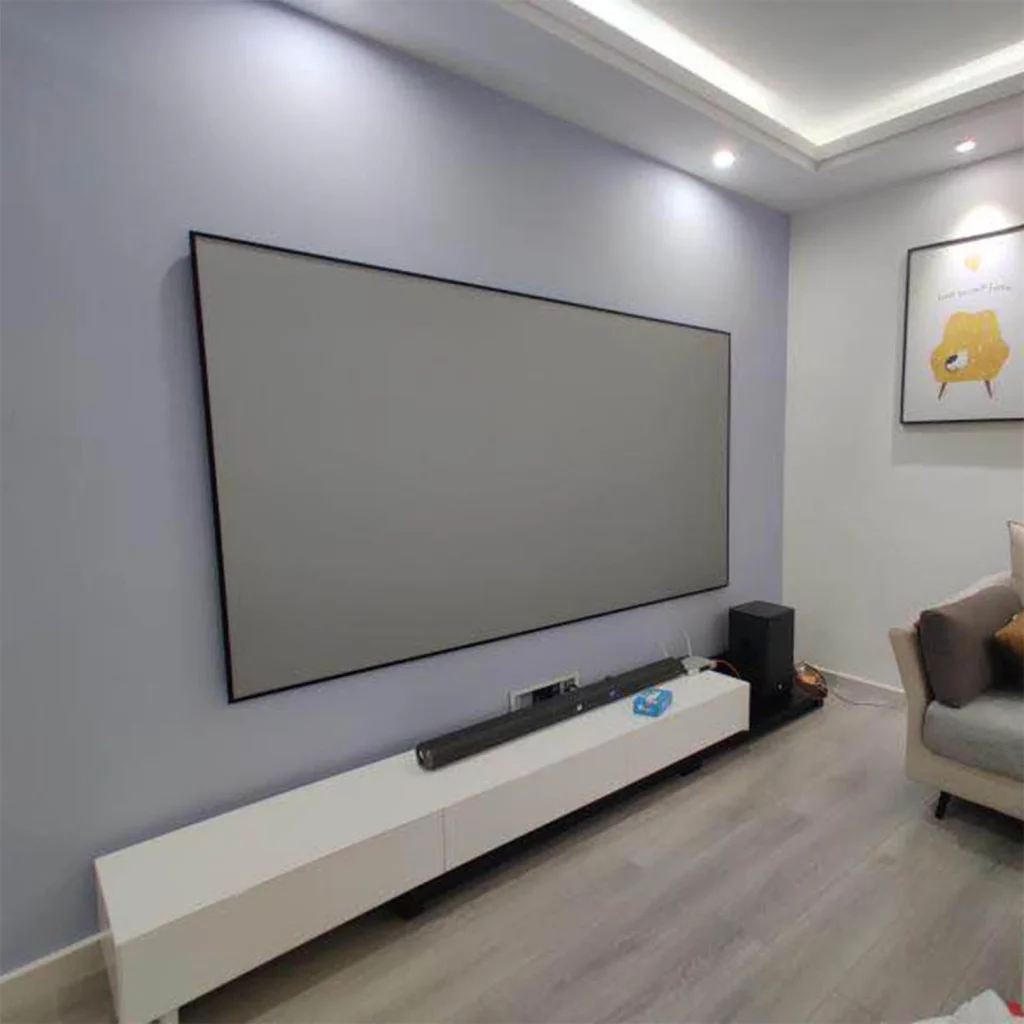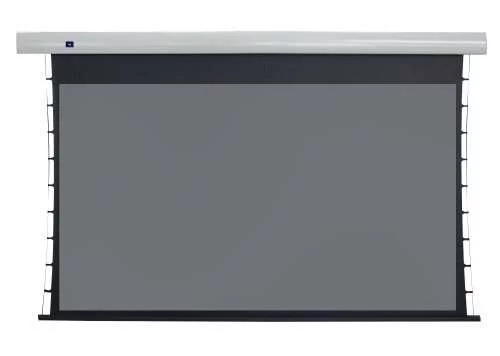In the captivating world of home theater and cinematic experiences, the choice of your projector screen is akin to selecting the perfect canvas for a masterpiece. While the traditional white screens have long been the norm, there’s an intriguing shift towards the allure of grey projector screens. But what sets grey screens apart and why should you consider them? In this enlightening blog post, we’ll take you on a journey through the merits, applications, and crucial factors to ponder when opting for a grey projector screen.
Grasping the Basics
Before we dive into the merits of grey screens, let’s lay the foundation by understanding the core elements. Projector screens come in a variety of types, ranging from fixed-frame screens to motorized ones, portable screens, and more. What truly differentiates these screens is the material they’re crafted from, and this material profoundly influences your viewing experience.

Unveiling the Significance of Screen Material
The material of your projector screen is not to be underestimated; it holds the key to how light interacts with the surface. Two key characteristics to consider are gain and color. Gain measures the screen’s reflectivity, while color pertains to the hue of the screen.
Exploring the Advantages of Grey Projector Screens
Now, let’s uncover the reasons why choosing a grey projector screen can be a game-changer for your home theater or projection setup:
- Elevates Contrast Ratio:
Among the standout advantages of grey projector screens is their remarkable ability to enhance contrast. These screens possess lower gain compared to conventional white ones, resulting in reduced reflection of ambient light. This reduction translates into deeper blacks and heightened contrast between the brightest and darkest elements on your screen. The outcome is a more immersive and lifelike visual experience that truly captivates.
- Accentuates Black Levels:
Grey screens have a knack for delivering exceptional black levels, making them a top choice for settings with subdued lighting. This feature takes center stage for those who prioritize impeccable image quality, yearning to savor movies with authentic shadows and dark scenes.
- Suppresses Hots potting:
Hot spotting, where the center of the screen appears brighter than the rest, is a phenomenon you won’t encounter with grey projector screens. They ensure a uniform brightness distribution across the entire projection surface, guaranteeing a consistent visual treat for all viewers.
- Rejects Ambient Light:
Grey projector screens excel at rejecting ambient light, a trait that serves them well in rooms where light conditions may not be ideal. Whether it’s controlled indoor lighting or intermittent natural light, a grey screen upholds image quality even when the setting isn’t picture-perfect.
- Expansive Viewing Angles:
Modern grey screens are engineered with wide viewing angles, ensuring that every member of your audience enjoys a crystal-clear and vibrant image. This attribute proves invaluable for larger gatherings and home theaters designed to accommodate multiple viewers.
Applications of Grey Projector Screens
Grey projector screens find their place in diverse settings where image quality and contrast reign supreme:
- Home Theaters:
For those who crave an authentic cinematic experience within the cozy confines of their home, grey projector screens are the ultimate choice. These screens elevate image quality, especially in dimly lit rooms, allowing viewers to extract the most from their high-definition projectors.
- Conference Rooms:
In professional settings, grey screens can significantly enhance presentations and video conferences. They maintain image clarity even in well-lit meeting spaces, ensuring effective communication.
- Gaming Rooms:
Gamers are often drawn to grey screens for their ability to deliver richer blacks and more vibrant colors. This enhancement significantly amplifies the gaming experience, whether you’re immersed in fast-paced action games or exploring expansive open-world landscapes.
- Sports Bars and Restaurants:
Public venues like sports bars and restaurants benefit greatly from grey screens, as they need to contend with varying lighting conditions. Patrons can revel in major sporting events or live performances without any compromise in image quality.
Crucial Considerations for Choosing a Grey Projector Screen
While grey projector screens offer a plethora of advantages, several factors should be weighed carefully before making your selection:
- Room Lighting:
Assess the lighting conditions within the room where you intend to install the projector screen. In environments devoid of light, a high-gain white screen may suffice. However, if there’s moderate ambient light or controlled artificial lighting, a grey screen emerges as the superior choice.
- Projector Brightness:
The brightness output of your projector plays a pivotal role in determining the appropriate screen material. Grey screens complement higher-lumen projectors effectively, compensating for their lower gain. Ensuring that your projector can deliver the desired level of brightness is paramount.

- Viewing Distance:
Take into account the distance between the projector and the screen, as well as the viewing distance from the screen. These variables significantly impact your choice of screen material and size. Grey screens are particularly effective for shorter throw distances.
- Screen Gain:
Grey projector screens are available in a range of gain values. Lower-gain screens are ideal for rejecting more ambient light, while higher-gain ones work well in darker environments. Carefully select the gain value that aligns with your specific room conditions.
- Budget Considerations:
It’s imperative to account for your budget, as grey projector screens typically command a slightly higher price point compared to standard white screens. Ensuring that your choice aligns with your financial considerations is prudent.
Conclusion
Opting for a grey projector screen can substantially elevate your viewing experience, particularly in environments where contrast and ambient light rejection assume paramount significance. Whether you’re in the process of setting up a home theater, configuring a conference room, or establishing a gaming haven, the merits of a grey screen are undeniable. By meticulously assessing room lighting, projector specifications, viewing distances, and budgetary constraints, you can make an informed decision that breathes life into your visuals with exceptional clarity and contrast.
If you aspire to propel your projection setup to the next echelon, a grey projector screen may be the missing link that enables you to attain cinema-quality visuals within your own cherished space.
Frequently Asked Questions (FAQ)
1. What is a grey projector screen?
A grey projector screen is designed with a neutral grey surface that enhances contrast and black levels in projected images, especially in rooms with ambient light. Unlike traditional white screens, grey screens improve image quality by reducing washout from external light sources.
2. Why should I choose a grey screen over a white screen?
Grey screens are ideal for:
-
High ambient light environments (living rooms, offices)
-
Improving contrast & black levels for a more cinematic experience
-
Projectors with lower brightness, as they compensate for light interference
3. Are grey screens suitable for 4K and HDR content?
Yes! Grey screens enhance contrast and color accuracy, making them excellent for 4K, HDR, and high dynamic range content by preserving deeper blacks and richer colors.
4. Do grey screens work with all projectors?
Most modern projectors (DLP, LCD, Laser) work well with grey screens. However, ultra-short-throw (UST) projectors may require specific screen materials to avoid hot spotting.
5. How does a grey screen perform in a dark home theater?
In a fully light-controlled room, a grey screen still improves contrast compared to a white screen, but the difference is less dramatic than in ambient light conditions.




